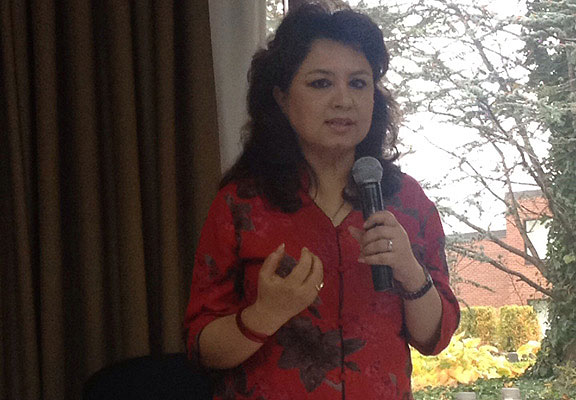

Credit: Lee Webster
(WOMENSENEWS)– Global frameworks and national commitments paint a rosy picture for women’s participation in peace processes in countries emerging from violent conflict.
But that picture gets badly smudged when you listen to activists with small, crucial, women’s rights organizations in countries such as Colombia, Nepal, Kenya and Kosovo. Over and over they make the same plea for more funding from the international community.
Local communities need shelters for survivors of sexual violence, bus fares to attend district planning meetings and opportunities to train women with the skills to rebuild livelihoods shattered by war. Too many of these projects in post-conflict societies operate on shoestrings.
“Donors look for the easiest way of dispersing funds,” says Bandana Rana, executive chair of Saathi, a women’s rights organization in Nepal. “They give it to big aid agencies and don’t want to take a so-called risk on women’s organizations who may not have administered large amounts of funding before.”
Rana says her group can always secure some money for high profile events, “where the donor’s logo will be profiled, such as anniversaries of Resolution 1325, or when we are supporting the government to develop a new National Action Plan on women, peace and security. But when it comes to the nitty gritty, the money disappears.”
I met Rana in New York during an early November gathering of over 60 civil-society activists, representatives of governments, the U.N. and NATO. We met to discuss the role of governments in supporting women’s rights in conflict and their full involvement in peace processes.
New Resolutions, Recommendations
The meeting followed two new U.N. Security Council resolutions on women, peace and security and a new CEDAW (Committee on the Elimination of Discrimination against Women) general recommendation on women and conflict.
These new global commitments build on an impressive set of U.N. resolutions, which began in 2000 with the adoption of U.N. Resolution 1325, the first to recognize the specific impacts of conflict on women and their central role in peace building and reconstruction.
Over 40 countries (and counting) have National Action Plans or are part of Regional Action Plans to implement the resolutions, committing themselves to ensure that women are at the heart of peace processes. These include conflict-affected countries such as Burundi and Nepal, and donor countries including the Netherlands, Finland, the United States and the United Kingdom.
In every community affected by conflict, women are organizing at the local level for peace, as concluded in the report From the Ground Up by Womankind Worldwide, an international women’s rights charity where I’m the head of policy and influencing.
Donor governments queue up to make global commitments, but implementation is a different story.
“There is limited awareness for the U.N. resolutions and what they mean, especially among rural women,” Lydia Gachoya, a Kenyan activist and vice president of the Regional Women Forum of the Great Lakes, told me. “There’s also a real lack of funding to raise awareness and engage in advocacy. With little or no funding, the formulation and implementation of plans for women, peace and security become an uphill struggle.”
A Good Model
Burundi offers a good model for how things can be done. There, female parliamentarians, supported by the women’s movement, successfully lobbied for earmarked funding to accompany the Burundian National Action Plan. Intermediary women’s funds–such as the Urgent Action Fund for Women’s Human Rights and Mama Cash–are experts in dispersing money to smaller organizations that cannot access larger donor funds.
Some donor countries, including the Netherlands, have specific funds for promoting women’s political participation and leadership. But it’s not enough.
Women continue to be systematically marginalized from peace processes and decision-making.
Of all the major peace agreements signed between 1992 and 2010, only 2.5 percent of signatories were women, according to a UN Women study. As of December 2012, women headed four of the 27 (15 percent) peacekeeping, political and peace building missions globally, a drop from six out of 28 (21 percent) in 2011. While women organize for peace at a grassroots level, they are excluded from peace talks at national and regional levels.
The U.N. secretary general, in his seven point plan on Women, Peace and Security (2010), committed to ensuring a minimum of 15 percent of U.N. post-conflict program spending on meeting women’s needs and building their capacities. The U.N. has not met that admirable target. However, it is attainable and member states can and should be emulating it.
We need governments to put both women and men at the heart of conflict resolution. Simply stated, no women, no peace.
Lee Webster is the head of policy and influencing at Womankind Worldwide and chair of the Gender Action for Peace and Security, or GAPS, network in the United Kingdom.
Would you like to Comment but not sure how? Visit our help page at https://womensenews.org/help-making-comments-womens-enews-stories.
Would you like to Send Along a Link of This Story? https://womensenews.org/story/peace/131119/women-cant-build-global-security-shoestring


